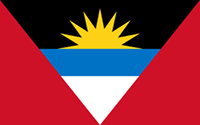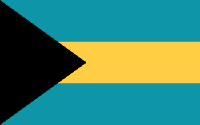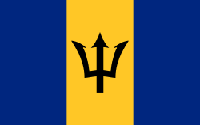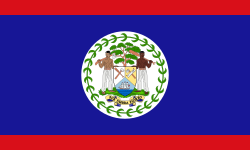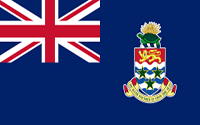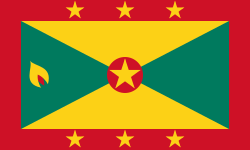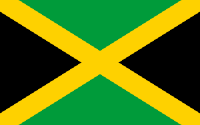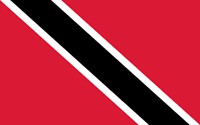
|
 |
 Coral reef conservation in context:
Marine Spatial Planning and Integrated Coastal Zone Management
Multiple, regulated uses of coastal and marine areas
The diagram below illustrates some of the many possible uses of coastal and marine areas that are subject to spatial planning and regulatory management. The relationship of this broader context to coral reef conservation is described below.
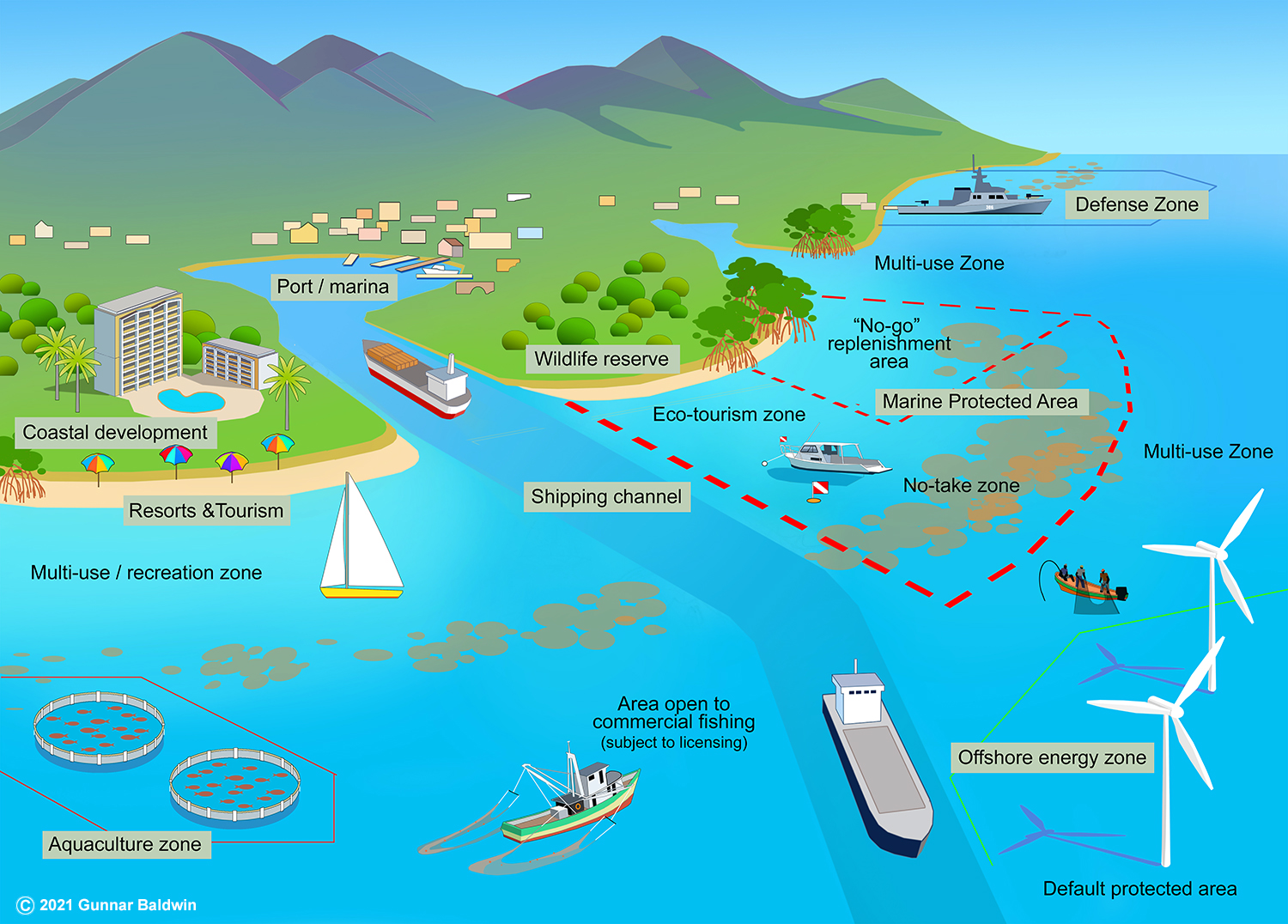
Measures to conserve and protect coral reefs are often implemented within the broader context of two interrelated disciplines: marine spatial planning (MSP) and integrated coastal zone management (ICZM). Both mechanisms seek to balance important ecological, social, economic, and cultural uses of coastal zone and marine areas. Marine spatial planning refers to a participatory public process through which information about human uses and natural ecosystems are used to allocate specific geographically-defined areas of territorial sea (and adjoing coastlines) for different uses to achieve economic, environmental, and social objectives.1 Both MSP and ICZM may define overarching frameworks for managing ongoing development, including provisions for implementation, monitoring, and enforcement of management rules. Once marine spatial plans have been defined, the geographic zones they define tend to be more or less static until a revision is undertaken.
Although ICZM is often defined in similar terms to MSP, it is a strategy that often involves a more dynamic and continuous set of processes for evaluating specific ongoing development issues within the coastal zone (including the EIA process) and the application of rules and guidelines to specific circumstances. In the context of ICZM, there can be a greater need for ongoing coordination among sectoral agencies in evaluating specific proposed development projects and issues.2 ICZM can potentially operate within the context of MSP and applying the management framework it provides. In addition, ICZM is generally concerned with a narrower geographic scope: areas of land and sea within two kilometers of the shoreline.3 According to the definition of ICZM adpted by the European Union, the term "integrated" in ICZM refers to the integration of both objectives and the mechanisms needed to fulfill the objectives, including "all relevant policy areas, sectors, and levels of administration" as well as the "integration of the terrestrial and marine components of the target territory, in both time and space."4
The diagram below illustrates one way of conceptualizing this relationship:5
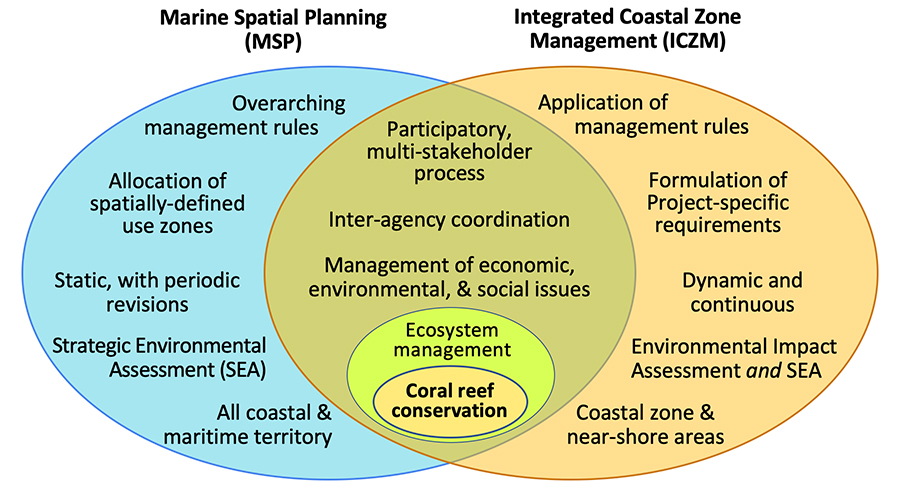
It is important to note that there is no single correct framework for delineating MSP issues and ICZM issues. Depending on the country and the system adopted, these may be separately defined, one may be contained within the other, or neither may be defined. Many cross-cutting issues exist (such as inter-sectoral coordination) that are critical in both contexts. Both mechanisms highlight the legal and practical issues involved in balancing environmental, social, economic, and cultural concerns in coastal areas.
Within the realms of MSP and ICZM, the designation of marine protected areas (MPAs) is generally considered an integral component of MSP, since it involves the designation of permanent spatially-defined zones that are infrequently subject to boundary adjustments. Conversely, the planning and approval process for specific projects that may impact the health of coral reefs, such as the construction of beach-front resorts, dredging of a shipping channel, or other activities that may release sediments and pollutants, would fall within the purview of ICZM. Management rules established in marine spatial plans often govern or interoperate with aspects of the coastal zone planning process. In both the MSP and ICZM contexts, robust stakeholder participation involving communities dependent on coastal natural resources, industry organizations, and relevant sectoral government agencies is key to effective implementation.
– Back to top of page –
Topics addressed in MSP and ICZM plans and related legislation* Draft version: for discussion only
| Topic or issue |
Marine Spatial Planning (MSP) |
Integrated Coastal Zone Management (ICZM) |
|
|
| A. General |
| Geographical scope |
e.g., All territorial waters, EEZ, shoreline, and coastal estuaries |
e.g., Land within prescribed distance of coastline or elevation, shoreline, and near-shore marine areas and estuaries |
| Substantive scope |
Existing and potential uses of maritime space
Inter-sectoral planning, management and coordinated application of all human activities
Mechanisms for inter-sectoral coordination
Strategic environmental assessment (SEA) |
Existing and potential uses of the coastal zone
Inter-sectoral planning, management and coordinated application of all human activities
Mechanisms for inter-sectoral coordination
SEA and environmental impact assessment (EIA), for terrestrial, as well as shoreline, and near-shore human activities.
|
| Goals/vision/policy/strategy |
Holistic "blue growth" goals, vision, strategy, and guiding principles (encourages investment, jobs, and growth; promotes the country's tourism & marine products)
Climate change, disaster preparedness, & vulnerability
Identify issues and stakeholders
|
Holistic sustainable development goals, vision, strategy, and guiding principles (May contain holistic vision as well as rules for managing specific details)
Climate change, disaster preparedness, & vulnerability
Facilitate specific investment projects according to MSP and ICZM frameworks
Strategic projects (e.g., new port or public marketplace)
|
| Balancing of goals |
How economic, social, cultural, and environmental goals should be balanced (generally) |
How economic, social, cultural, and environmental goals should be balanced (specific application)
|
| Plan adoption, modification, & revocation
|
More static—once adopted, infrequent adjustments |
More dynamic, day-to-day application and adaptive management
|
| Relationship of plan to other laws and policies |
Cross-cutting issues that relate in a variety of ways with all other sectors |
| B. Institutional & administrative |
| Government coordination & administration |
Inter-sectoral coordination of strategic objectives and uses of marine areas |
Inter-sectoral coordination in evaluating new development plans and enforcement |
| Advisory Bodies |
Advisory body used for planning and management |
Advisory body used for planning and management |
| Authorities |
Environmental, fisheries, maritime, and other marine sectoral authorities, coastal defense force, police, and coordination with all other relevant sectoral agencies |
Environmental authorities, coastal defense force, police, development control & planning boards, and coordination with all sectoral agencies relevant to general planning and specific projects |
| Nongovernment stakeholders |
Relevant nongovernment stakeholders affected by projects—local residents reliant on fishing & aquaculture, local communities; hotel owners, dive boat & fishing charter operators, and marina owners; NGOs, researchers, and tourists |
| Traditional Institutions |
Incorporation of traditional institutions in all circumstances where their interests are affected |
| C. Sectoral issues |
| Environment |
Establishing zones (including MPAs) & zone-specific rules
Conduct audit of land-based and sea-based pollution sources
Fulfill international/MEA and trans-boundary responsibilities |
Establish zones (including MPAs) & zone-specific rules
Marine pollution from land-based and coastal sources
Fulfill international/MEA and trans-boundary responsibilities
Degradation of mangroves
Water quality standards
Recommendations & guidelines for protecting scenic and cultural areas
Biodiversity protection
|
| Fisheries and aquaculture |
Establish and clarify zones for commercial fishing, aquaculture, and exclusion of foreign vessels |
Coordinate fisheries and aquaculture issues with coastal zone management plans
|
| Defense |
Maintain security and exclusion zone around military assets and operations |
Provide security & input on development issues; enforcement of marine laws (including customs, shipping, & foreign fishing vessels) |
| Physical development & infrastructure |
High-level planning and policy-making for many issues
(May have more detailed plans & regulations for maritime issues
Participation by all relevant authorities and stakeholders |
Planning, policy-making, and evaluation & approval of specific projects and activities
Zoning (fishing marinas & fish markets, tourism, industrial parks, etc.)
Building codes & sustainable built environment
Plans and standards for roads, bridges, and related infrastructure
Sustainable mobility
Green public procurement |
| Shipping |
Designate transit zones & channels
Dredging rules and standards |
Designate transit zones & channels
Dredging rules and standards
|
| Energy |
Establish zones for oil & gas drilling, offshore wind farms, and other projects
Provisions for impact assessment and risk management |
Establish plans, rules, and infrastructure blueprint for energy development
Plans, rules and standards for powerline siting and construction
|
| Hospitality & tourism |
Establish zones for marine tourism, hotels, marinas, ferry services, and other hospitality-related businesses
Establish strategy and opportunities for marine and coastal tourism growth
|
Establishing & applying rules within zones
Standards for beach enhancement structures & breakwaters, destabilization of coastal cliffs and dunes, removal of coastal vegetation (including mangroves), back-filling, and reclamation of wetlands
Provisions for beach access
|
| Agriculture & industry |
Incorporate terrestrial agriculture and industry needs into high-level plan |
Standards and codes for agricultural and industry activities that impact coastal zone ecosystems |
Water & waste treatment
Public health |
Incorporate water and waste-treatment needs into high-level plan |
Establish & enforce rules & regulations for water use and wastewater treatment
Air, water, soil quality & health standards |
| Mining, dredging, & sand extraction |
Zones & rules established |
Zones & rules established |
| Education |
Public awareness of overarching vision for "blue economy" |
Enhance educational programs and public awareness of coastal zone issues |
| D. Marine Protected Areas |
| Plan Elements & Criteria |
- Designation of MPA boundaries and purpose
- Rules and guidelines for management of MPAs and other restricted areas
|
| Monitoring and detection |
Plans, systems, technology, and equipment for monitoring use and detecting violations |
| Enforcement |
- Criteria for enforcement response:
Simple unambiguous boundaries boundaries, clear restrictions and exceptions, easily enforceable provisions (e.g., no take zones, presumptions concerning possession of prohibited gear)
- Single point of access & embarkation (efficient tracking of visitors) and cearly defined permitting process
|
| Rules and procedures for engagement |
- Powers of search, arrest, and seizure
- Warnings, notices, and injunctions
- Prosecution, tribunals, and penalties
- Natural resource damages: restitution and cost recovery
- Citizen lawsuits
|
| Research |
Clearly defined process for obtaining research permits, reporting, & revocation |
| Recreational use |
Clearly-defined regulations |
| E. Public Participation & Access to Information |
| Ensuring Access to Information and public consultation |
Definition of what is public; Publish and disseminate time and place of public hearings;
How to view publicly accessible information |
| Responding to & Incorporating Public Input |
As relates to coastal zone plans and evaluation of new developments |
| F. Regulatory requirements |
| Rules concerning uses permitted within designated zones |
Generally, broader restrictions |
Generally, more specific restrictions |
| G. Compliance & Enforcement (General) |
| Designation of enforcement authorities |
Defense force/coast guard, customs officials, police, fisheries officiers, etc. (dependent on restrictions being enforced) |
Defense force/coast guard, police, fisheries officiers, park wardens, inspectors for development control authorities, etc. (dependent on restrictions being enforced) |
| Monitoring and detection |
Plans, systems, technology, and equipment for monitoring use and detecting violations |
| H. Miscellaneous |
| Conflicts between user groups & conflict resolution |
Procedures and/or decision-making bodies for resolving conflicts between users |
| Regional & international harmonization |
Compliance with international agreements and coordination of transboundary issues |
| Grandfathering of existing activities |
Provisions for grandfathering existing activities (e.g., local artisenal fishing) |
| Traditional rights & management |
Provisions for incorporating and recognizing traditional rights |
*Note: This is not an exhaustive list. It contains a number of selected organizations that have been prominent in the protection and restoration of coral reefs. The elements of this table were synthesized from the sources listed below.
References
Barragán Muñoz, Juan M. (October 2019), Progress of coastal management in Latin America and the Caribbean, Ocean and Coastal Management, 184:105009 DOI: 10.1016/j.ocecoaman.2019.105009.
Belize, Coastal Zone Management Act (2000, Ch. 329).
Blue Prosperity Coalition (2020), Designing Marine Spatial Planning Legislation for Implementation:
A Guide for Legal Drafters.
CARICOM (2017), Caribbean Community Environmental and Natural Resources Policy Framework.
Environmental Law Institute (January 2015) Mengerink, Kathryn and Austin, Jay, Evaluating Ocean Protection, Policy Brief No. 9.
Environmental Law Institute (September 2016), Legal Tools for Strengthening Marine Protected Area Enforcement.
Grenada (2015), Integrated Coastal Zone Management Policy for Grenada, Carriacou and Petite Martinique.
Grenada (2019), Integrated Coastal Zone Management Act (2019, Act 8).
Trinidad and Tobago, Inter-Ministerial Committee Ministry of Planning and Development (2019), Draft Integrated Coastal Zone Management Policy Framework.
UNEP (2018), Conceptual guidelines for the application of Marine Spatial Planning and Integrated
Coastal Zone Management approaches to support the achievement of Sustainable Development Goal Targets 14.1 and 14.2. UN Regional Seas Reports and Studies No. 207.
UNEP/Caribbean Environment Programme (2019), Protocol Concerning Specially Protected Areas and Wildlife in the Wider Caribbean Region - A regional legal framework for biodiversity.
Endnotes
1. IOC-UNESCO (2006), Why Marine Spatial Planning Matters, http://msp.ioc-unesco.org/. According to UNESCO, MSP refers to "a public process of analyzing and allocating the spatial and temporal distribution of human activities in marine areas to achieve ecological, economic and social objectives that have been specified through a political process.".
Blue Prosperity Coalition (website), What is Spatial Planning?, https://www.blueprosperity.org/marine-spatial-planning. The Blue Prosperity Coalition defines marine spatial planning as "an approach that uses spatial information about natural resources and human uses to develop a comprehensive ocean management plan".
2. See e.g., European Union/RISC-KIT, Spatial Planning and Integrated Coastal Zone Management, https://www.coastal-management.eu/measure/spatial-planning-and-integrated-coastal-zone-management-iczm; EU International Ocean Institute (2006), Evaluation of Integrated Coastal Zone Management (ICZM) in Europe, https://ec.europa.eu/environment/iczm/pdf/evaluation_iczm_summary.pdf.
3. European MSP Platform, Land-Sea interactions in MSP,
https://www.msp-platform.eu/faq/land-sea-interactions-msp.
"Whilst Maritime Spatial Planning and Integrated Coastal Management (ICM, sometimes referred to as Integrated Coastal Zone Management or ICZM) both involve a strategic approach to planning within the marine environment in terms of uses and activities, the main difference between the two are the scales to which they can be applied. Typically ICM is applied to marine zones less than two kilometres from the coastline, conversely MSP can be applied to much wider areas such as coastal watersheds or Exclusive Economic Zones (EEZ)."
4. European Environmental Agency, integrated coastal zone management, https://www.eea.europa.eu/help/glossary/eea-glossary/integrated-coastal-zone-management.
5. This diagram represents a synthesis of information drawn from a variety of sources consulted by the author. It is inherently overly simplistic, due to the wide variations that exist in applying these concepts at the national level. Recommendations for improving this diagram would be greatly appreciated.
Back to the Caribbean Law Page

|


